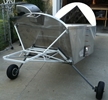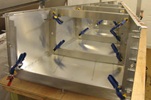


random user submitted photo
Secondary ignition confusion
2 posts
• Page 1 of 1
Secondary ignition confusion
-----
Last edited by Fastcapy on Tue Feb 24, 2015 3:49 pm, edited 1 time in total.
Mike Beck
Oshkosh, WI (KOSH)
Sonex #1145 N920MB
Std Gear, Modified Aerovee, Rotec TBI, Dual Stick, Acro Ailerons
MGL Panel
Airworthiness: 10/24/13, First Flight: 05/18/14
Oshkosh, WI (KOSH)
Sonex #1145 N920MB
Std Gear, Modified Aerovee, Rotec TBI, Dual Stick, Acro Ailerons
MGL Panel
Airworthiness: 10/24/13, First Flight: 05/18/14
- Fastcapy
- Posts: 335
- Joined: Sun Jan 12, 2014 11:45 am
- Location: KOSH
Re: Secondary ignition confusion
I'm not sure I can explain it, but I can verify that my engine does the same. It's something to do with how the magnetrons work...they change the timing of the spark depending on the rpm of the engine.
http://www.foxvalleykart.com/timing2.html
"Now let's look at the venerable Briggs & Stratton and its "Magnetron" ignitions system. It seemed impossible to believe when Briggs told us we could yank out the points and condenser that had served us to well for years and plug that little box in their place. Well, not only does it work, but also it works better than the old points ever did. Here's how: The magnetron coil actually contains 3 separate coils of windings. In addition to the primary and secondary windings, there is a 3rd winding, called the "trigger" coil." When the leading edge of the magnets in the flywheel approach the coil, the magnetic field surrounding those magnets generates a small voltage (about 1 volt) that powers a solid-state switching device called a Darlington Transistor, turning the transistor "on." That "on" mode completes the circuit on the primary winding and a current of about 3 amps flows to ground on the crankcase (Figure 2). As the flywheel continues to rotate that current builds the magnetic field in the secondary winding.
When the trailing edge of the magnets in the spark plug gap. the flywheel reaches the trigger coil, a second small current is induced in the trigger coil and that current tells the transistor to "turn off", effectively breaking the circuit of the primary winding to ground (Figure 3). As we discussed last month, the sudden break causes the magnetic field to collapse. Since current (amperage) and voltage are inversely proportional, suddenly stopping the current flow causes the voltage to "spike" as it compensates. It's that spike that builds the voltage required in the secondary winding to jump the sparkplug gap and ignite the mixture. By the way, in the Magnetron coil, the primary winding has 74 turns of wire and the secondary has 4400. That's a 59.5:1 ratio and that helps insure that there's enough voltage to get the job done. All this, the initial current in the trigger coil, the buildup of potential, the second trigger coil pulse, and the collapsing field with the resulting voltage spike and spark, in on about 10 degrees of crank rotation. That means that at 6000 RPM the whole thing, start to finish, only takes about 0.00027 seconds. Pretty amazing.
This simple, but very effective, spark control system even advances the ignition timing, causing the plug to fire earlier (in degrees of crank rotation) as RPMs go up."
http://www.foxvalleykart.com/timing2.html
"Now let's look at the venerable Briggs & Stratton and its "Magnetron" ignitions system. It seemed impossible to believe when Briggs told us we could yank out the points and condenser that had served us to well for years and plug that little box in their place. Well, not only does it work, but also it works better than the old points ever did. Here's how: The magnetron coil actually contains 3 separate coils of windings. In addition to the primary and secondary windings, there is a 3rd winding, called the "trigger" coil." When the leading edge of the magnets in the flywheel approach the coil, the magnetic field surrounding those magnets generates a small voltage (about 1 volt) that powers a solid-state switching device called a Darlington Transistor, turning the transistor "on." That "on" mode completes the circuit on the primary winding and a current of about 3 amps flows to ground on the crankcase (Figure 2). As the flywheel continues to rotate that current builds the magnetic field in the secondary winding.
When the trailing edge of the magnets in the spark plug gap. the flywheel reaches the trigger coil, a second small current is induced in the trigger coil and that current tells the transistor to "turn off", effectively breaking the circuit of the primary winding to ground (Figure 3). As we discussed last month, the sudden break causes the magnetic field to collapse. Since current (amperage) and voltage are inversely proportional, suddenly stopping the current flow causes the voltage to "spike" as it compensates. It's that spike that builds the voltage required in the secondary winding to jump the sparkplug gap and ignite the mixture. By the way, in the Magnetron coil, the primary winding has 74 turns of wire and the secondary has 4400. That's a 59.5:1 ratio and that helps insure that there's enough voltage to get the job done. All this, the initial current in the trigger coil, the buildup of potential, the second trigger coil pulse, and the collapsing field with the resulting voltage spike and spark, in on about 10 degrees of crank rotation. That means that at 6000 RPM the whole thing, start to finish, only takes about 0.00027 seconds. Pretty amazing.
This simple, but very effective, spark control system even advances the ignition timing, causing the plug to fire earlier (in degrees of crank rotation) as RPMs go up."
- radfordc
- Posts: 573
- Joined: Fri Jun 03, 2011 9:39 am
2 posts
• Page 1 of 1
Who is online
Users browsing this forum: No registered users and 38 guests







